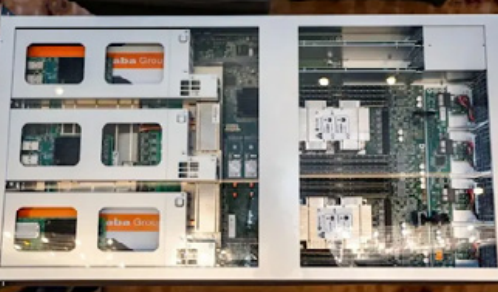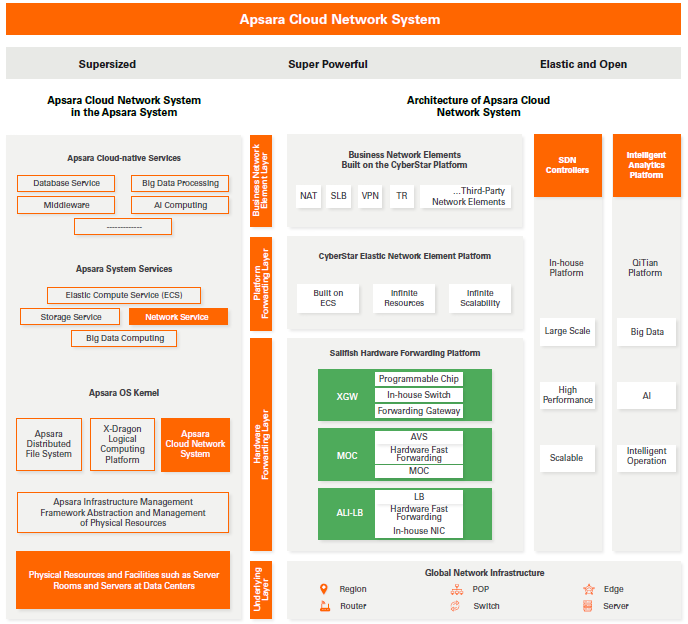
Zhu Shunmin, Head of Alibaba Cloud Network Services
According to its narrow definition, cloud-native entails microservices, containers, continuous delivery, and DevOps. However, I believe that the wide application of cloud computing is redefining cloud-native, which may become more inclusive. In a broad sense, cloud-native simply refers to any software, hardware, or architecture intended for cloud use. As a typical and core Infrastructure as a Service (IaaS) product of cloud computing, the cloud network was born from the cloud and for the cloud. In fact, it is the real cloud-native network
Apsara Cloud Network System is an in-house cloud-native system built for the cloud through the support of other cloud capabilities. It represents the unique way we, at Alibaba Cloud, develop cloud-native technologies. Apsara Cloud Network System encompasses capabilities such as large-scale software-defined network (SDN) control, Sailfish software-hardware integrated forwarding and CyberStar elastic.


SDN controllers play a key role in the efficient management of a large data system. In the trend of cloud-native applications, a great number of users are using Docker and Kubernetes in the cloud. It poses a huge challenge to the size and density of cloud networks. SDN controllers enable users to accommodate large amounts of instances in a virtual private cloud (VPC) and meet their needs for highly densified elastic network interfaces (ENIs) on an Elastic Compute Service (ECS) instance. Also, given the scale of public cloud instances, management efficiency is critical. Cloud-native SDN controllers are built to take care of these issues and relieve users from worries about their data systems' massive size and complexity.

The Sailfish hardware forwarding platform is built on a hardware-software integrated architecture based on high-performance forwarding components such as dedicated programmable chips and intelligent network interface controllers (NICs). The platform is designed to enable high-performance data forwarding between hosts and primary gateways. The platform has been widely deployed in many cloud network applications in combination with core modules such as XGW, MoC, and ALI-LB.
The development of network devices often involves both software and hardware because they work together in a complementary way toward higher flexibility and performance. Before the birth of XGW, specific customers requested a hybrid cloud by using connections over Express Connect circuits with a jaw-dropping bandwidth of 10 Tbit/s.
Considering reasonable redundancy, nearly a hundred high-performance x86 servers were required, leading to unacceptable costs and operational efficiency. It encouraged us at Alibaba Cloud to develop XGW, a high-performance gateway with integrated hardware and software.

As more large enterprises migrate their business to the cloud, they often require higher elasticity to support scenarios such as live streaming and large promotional events. These scenarios frequently require a drastic capacity increase that traditional architecture built on x86 servers cannot meet.
Therefore, the elasticity based on the cloud-native ECS service becomes a natural choice. The most appealing feature of CyberStar, an elastic network element platform, is that the network elements are not deployed on bare metal servers or in resource pools dedicated to computing. Instead, they get deployed on Alibaba Cloud ECS instances, which means "infinite" resources and "infinite" scalability. As the business network elements no longer get deployed on traditional x86 physical servers, scalability problems such as a time-consuming deployment and complex scaling procedure have been solved. The CyberStar platform is now widely applied to core services such as Application Load Balancer (ALB), NAT Gateway, PrivateLink, CEN-TR, Global Accelerator (GA), and VPN Gateway.
On the 2020 IDC FutureScape webinar, IDC predicted a significant trend toward clouddedicated devices. By 2024, more than 25% of new workloads on public clouds will get processed by dedicated infrastructure components from service providers. I believe this day will arrive much earlier because cloud-native dedicated devices built on integrated hardware and software have already become a popular choice in cloud network-related business scenarios. Likewise, the CyberStar elastic network element platform built on the cloud-native ECS service has also been deployed to cope with a wide range of scenarios.
In the future, cloud network technologies will continue to evolve in these two directions, and the core advantages of cloud networks will rely on cloud-native architectures.

The Intelligent O&M Platform Helps LAIX Improve Its Core Competitiveness through AI and Big Data

1,081 posts | 271 followers
FollowAlibaba Cloud Community - February 3, 2023
AlibabaCloud_Network - April 19, 2019
AlibabaCloud_Network - December 19, 2018
AlibabaCloud_Network - September 19, 2018
Alibaba Cloud Community - September 1, 2022
AlibabaCloud_Network - June 30, 2021

1,081 posts | 271 followers
Follow Alibaba Cloud Flow
Alibaba Cloud Flow
An enterprise-level continuous delivery tool.
Learn More DevOps Solution
DevOps Solution
Accelerate software development and delivery by integrating DevOps with the cloud
Learn More Cloud Hardware Security Module (HSM)
Cloud Hardware Security Module (HSM)
Industry-standard hardware security modules (HSMs) deployed on Alibaba Cloud.
Learn More Networking Overview
Networking Overview
Connect your business globally with our stable network anytime anywhere.
Learn MoreMore Posts by Alibaba Cloud Community